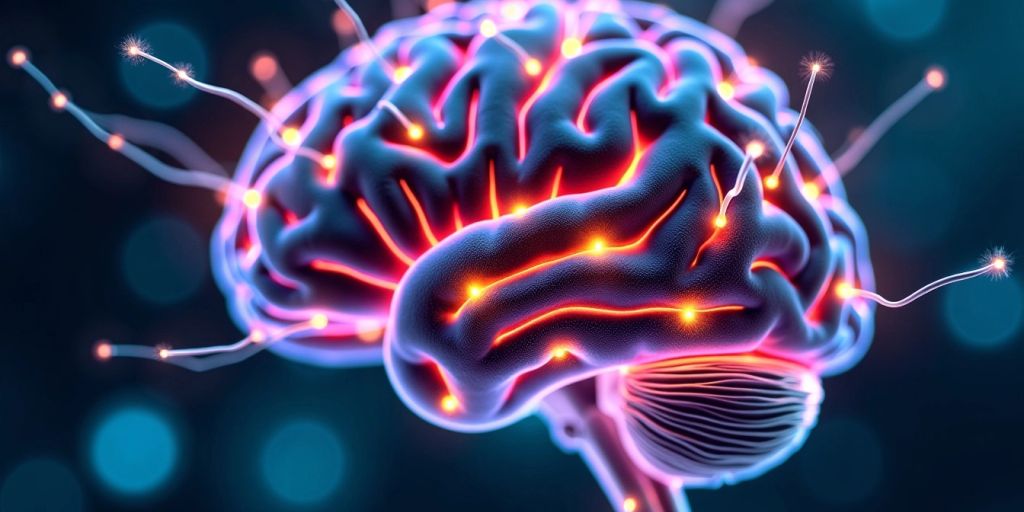Neuroplasticity is a fascinating concept in neuroscience that describes the brain’s ability to change and adapt throughout a person’s life. This ability allows our brains to form new connections, strengthen existing ones, and even recover from injuries. Understanding neuroplasticity can help us grasp how learning occurs, how we can recover from brain injuries, and how our experiences shape our brain’s structure and function.
Key Takeaways
- Neuroplasticity is the brain’s ability to change its structure and connections based on experiences.
- There are two main types of neuroplasticity: functional, which helps the brain adapt after injury, and structural, which involves physical changes in the brain due to learning.
- Neuroplasticity is most active during childhood but continues to occur throughout life.
- Factors like age, environment, and personal experiences can influence how neuroplasticity works.
- Understanding neuroplasticity can lead to better rehabilitation methods for brain injuries and enhance learning strategies.
Understanding Neuroplasticity
Definition of Neuroplasticity
Neuroplasticity is the brain’s ability to change and adapt based on experiences. This ability is crucial for brain health, allowing us to learn new things and recover from injuries. It involves the brain reorganizing its pathways and forming new connections.
Types of Neuroplasticity
There are two main types of neuroplasticity:
- Functional plasticity: This is when the brain moves functions from damaged areas to healthy ones.
- Structural plasticity: This involves the brain changing its physical structure as a result of learning and experience.
Importance of Neuroplasticity
Neuroplasticity is essential for several reasons:
- It helps in learning new skills.
- It allows recovery from brain injuries.
- It supports adaptation to new environments.
Neuroplasticity shows how our brains can adapt and grow, making it possible to overcome challenges and learn throughout life.
In summary, neuroplasticity is a vital process that enables the brain to adapt, learn, and recover, making it a key factor in our overall cognitive health.
Mechanisms Behind Neuroplasticity

Synaptic Pruning
Synaptic pruning is a process where the brain eliminates unused or weak connections between neurons. This helps to strengthen the important connections, making the brain more efficient. This process is crucial for learning and memory. Here are some key points about synaptic pruning:
- It occurs mainly during childhood and adolescence.
- It helps in refining neural networks.
- It can also happen in response to brain injuries.
Neurogenesis
Neurogenesis is the creation of new neurons in the brain. This process is vital for learning and adapting to new experiences. It mainly occurs in the hippocampus, a region associated with memory. Some important aspects include:
- Neurogenesis can be influenced by factors like exercise and stress.
- It plays a role in recovery from brain injuries.
- Research shows that neurogenesis decreases with age.
Cortical Remapping
Cortical remapping refers to the brain’s ability to reorganize itself by forming new connections. This is especially important after injuries. Here are some points to consider:
- It allows the brain to adapt to changes or damage.
- It can help recover lost functions after a stroke.
- Cortical remapping is a key aspect of rehabilitation.
The brain’s ability to adapt and change is a remarkable feature that allows us to learn and recover from injuries. Understanding these mechanisms can help us harness neuroplasticity for better outcomes in therapy and education.
Factors Influencing Neuroplasticity
Age and Development
Neuroplasticity changes as we age. Young brains are more adaptable and can form new connections quickly. For example, during early childhood, the brain undergoes rapid growth and organization. This is when developmental plasticity occurs, allowing neurons to sprout branches and form synapses. As we grow older, our brains still adapt, but the rate of change slows down.
Environmental Influences
The environment plays a big role in how our brains change. Here are some key factors:
- Social interactions: Engaging with others can stimulate brain activity.
- Physical activity: Exercise promotes brain health and can enhance neuroplasticity.
- Learning opportunities: New experiences and challenges encourage the brain to adapt.
Impact of Learning and Experience
Learning new skills or information can strengthen neural connections. This process is known as synaptic pruning, where unused connections are eliminated, making the brain more efficient. Experiences shape our brains, allowing us to learn and remember better.
Neuroplasticity is a lifelong process, meaning our brains can continue to adapt and change, regardless of age.
In summary, age, environment, and experiences all influence how our brains adapt and grow. Understanding these factors can help us harness the power of neuroplasticity for better learning and recovery.
Applications of Neuroplasticity
Rehabilitation After Brain Injury
Neuroplasticity plays a crucial role in helping individuals recover from brain injuries. The brain can create new pathways to compensate for damaged areas. This is especially important after events like strokes or traumatic injuries. Rehabilitation programs often focus on exercises that encourage the brain to adapt and reorganize itself.
Learning and Memory Enhancement
Neuroplasticity is also vital for improving learning and memory. Engaging in activities that challenge the brain, such as puzzles or learning a new language, can strengthen synaptic connections. Here are some effective strategies:
- Practice regularly to reinforce new skills.
- Stay curious and explore new subjects.
- Engage socially to stimulate cognitive functions.
Therapeutic Uses
Neuroplasticity has therapeutic applications in various conditions, including depression and anxiety. Techniques like cognitive behavioral therapy (CBT) leverage neuroplasticity to help individuals rewire negative thought patterns.
Neuroplasticity shows us that our brains are not fixed; they can change and adapt throughout our lives. This adaptability is key to recovery and growth.
| Application Area | Description |
|---|---|
| Rehabilitation After Brain Injury | Creating new pathways to compensate for damage. |
| Learning and Memory Enhancement | Strengthening connections through practice. |
| Therapeutic Uses | Rewiring negative thought patterns in therapy. |
Challenges and Limitations of Neuroplasticity
Negative Reorganization
Neuroplasticity can sometimes lead to negative changes in the brain. When the brain reorganizes itself after injury, it may not always restore functions correctly. Instead, it can create new pathways that do not work as well as the original ones. This can result in difficulties in movement or speech, depending on the area affected.
Age-Related Decline
As we grow older, the brain’s ability to adapt decreases. Younger brains are generally more flexible and can recover from injuries better than older ones. This decline in plasticity can make it harder for older adults to learn new skills or recover from brain damage.
Barriers to Effective Neuroplasticity
Several factors can hinder the brain’s ability to reorganize effectively:
- Genetic predispositions: Some individuals may have a genetic makeup that limits their brain’s adaptability.
- Chronic stress: High levels of stress can negatively impact brain function and plasticity.
- Lack of stimulation: Environments that do not challenge the brain can lead to reduced plasticity.
Neuroplasticity is a powerful tool, but it has its limits. Understanding these challenges can help us find better ways to support brain health and recovery.
Research and Future Directions in Neuroplasticity

Current Research Trends
Research in neuroplasticity is rapidly evolving, focusing on how the brain adapts and changes. Some key areas of study include:
- Understanding brain recovery after injuries.
- Exploring how neuroplasticity can enhance learning.
- Investigating the role of environmental factors in brain changes.
Potential for Stem Cell Therapy
Stem cell therapy is a promising area in neuroplasticity research. Scientists are looking into how stem cells can:
- Repair damaged brain tissue.
- Promote new neuron growth.
- Enhance recovery from strokes and other brain injuries.
Future Implications
The future of neuroplasticity research holds exciting possibilities. Innovative neurorehabilitation strategies are being developed for individuals recovering from brain injuries or strokes. This could lead to:
- Improved therapies for brain injury recovery.
- Enhanced learning techniques in education.
- New treatments for mental health disorders.
The potential of neuroplasticity is vast, and ongoing research will continue to uncover its secrets and applications.
Conclusion
In summary, neuroplasticity is a fascinating ability of the brain to change and adapt. It allows our brains to form new connections and even create new neurons based on our experiences. This means that whether we are learning something new, recovering from an injury, or adjusting to changes in our lives, our brains are constantly rewiring themselves. Understanding neuroplasticity helps us appreciate how resilient our brains can be and opens up possibilities for recovery and growth, no matter our age. So, the next time you learn a new skill or overcome a challenge, remember that your brain is working hard to adapt and grow!
Frequently Asked Questions
What is neuroplasticity?
Neuroplasticity is the brain’s ability to change and adapt. It allows neurons to form new connections and adjust how they work based on experiences and learning.
Why is neuroplasticity important?
Neuroplasticity is crucial because it helps us learn new things, recover from injuries, and adapt to changes in our environment.
Are there different types of neuroplasticity?
Yes, there are two main types: functional plasticity, which shifts functions to healthy parts of the brain, and structural plasticity, which changes the brain’s physical structure.
Can neuroplasticity happen at any age?
Yes, while the brain is most adaptable during childhood, neuroplasticity continues throughout life, allowing adults to learn and recover from injuries.
How can I improve my brain’s neuroplasticity?
You can enhance neuroplasticity through activities like learning new skills, practicing mindfulness, and engaging in physical exercise.
What are some challenges to neuroplasticity?
Challenges include age-related decline, negative changes in brain structure, and barriers like lack of motivation or support.



